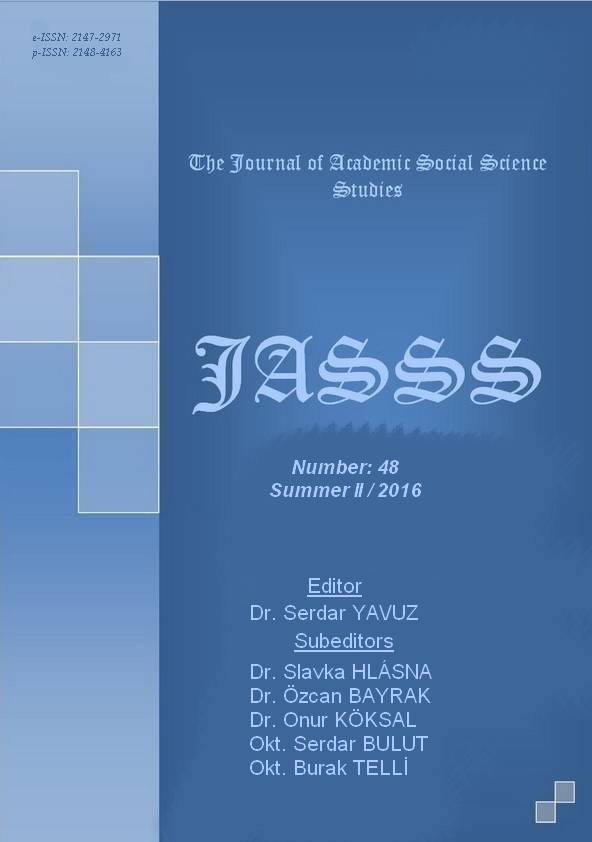Author :
Abstract
Eğretileme, iki şey arasında bağlantı kurmak veya bir benzerliği belirtmek için sözcüğün düz anlamından başka bir anlamda kullanılmasıdır. Lakoff & Johnson (2003) kültürel bir olgu olan eğretilemelerin düşünce, algı ve eylemleri yöneten kavramsal dizgeye egemen olduğunu savunmakta ve ‘Kavramsal Eğretileme Kuramı’ çerçevesinde eğretilemeleri yapısal, yönelimsel ve varlıksal olmak üzere üç başlık altında sınıflandırmaktadır. Eğretilemeler, kısa öykülerde sıklıkla karşılaşılan söz sanatlarındandır (Shaw, 2014); ancak yazın alanında daha önce Kavramsal Eğretileme Kuramı (Lakoff ve Johnson, 2003) çerçevesinde incelenmemiştir. Bu nedenle, kuramın kısa öykülerde nasıl işlediğini ölçmek için çalışmamızda insan ve doğa ilişkisinin konu edildiği iki kısa öyküde eğretileme kullanımı incelenmekte, eğretilemeler aracılığıyla doğa ve insan ilişkisine ilişkin nasıl bir kavramsal eğretilemenin kodlandığının saptanması hedeflenmektedir. Bu amaçla Karanfiller ve Domates Suyu (Sait Faik Abasıyanık) ve Bir Orman Hikayesi (Sabahattin Ali) öyküleri seçilmiştir. Bulgularımız her iki öyküde de en sık kullanılan eğretileme türünün varlıksal, en az sıklıkla kullanılanın ise yapısal eğretileme olduğunu göstermektedir. Ancak hem yeğlenen eğretileme türü hem de eğretilemelerle oluşturulan kavramlar arasında farklılık bulunmaktadır. Bir Orman Hikayesi’nde varlıksal eğretilemenin bir alt tipi olan varlık eğretilemesi çerçevesinde ele alınan kişileştirme eğretilemeleri daha yoğun olarak kullanmasının dışında en önemli fark doğa ile ilişkin olarak oluşturulan kavramlardır. Karanfiller ve Domates Suyu’nda DOĞA VE İNSAN ÇATIŞMA İÇERİSİNDEDİR eğretilemeli kavramı ile doğa ile insanın kavgası; Bir Orman Hikayesi’nde ise DOĞA İNSANDIR eğretilemeli kavramı ile de doğa ile insan arasında yakınlık ilişkisi kurgulanmaktadır. Bu saptamalar doğrultusunda, Kavramsal Eğretileme modelinin öyküde verilmek istenen iletinin ortaya konmasında etkin bir araç olduğu söylenebilir.
Keywords
Abstract
Metaphor is the use of a word to refer to something other than its denotative meaning to suggest some resemblance or make a connection between the two things. Lakoff & Johnson (2003) argue that metaphors, a cultural phenomenon, dominate our conceptual system which controls our thoughts, perceptions and actions and explain this case within the framework of ‘Conceptual Metaphor Theory’ and classify metaphors in three types, i.e. structural, orientational and ontological. Metaphor is a type figurative language used frequently in short stories (Shaw, 2014); however it has not been studied under the theory of ‘Conceptual Metaphor’ (Lakoff & Johnson, 2003). Thus, in order to find out how the theory works in short stories, metaphor is studied in two different short stories on the relationship of human beings and nature and aimed to reveal how the relationship between human beings and nature is encoded via metaphors. To this end, Carnations and Tomato Juice (Sait Faik Abasıyanık) and The Story of a Forest (Sabahattin Ali) have been selected. The findings of the analysis of the stories in our database show that the most frequently preferred type of metaphor is ontological whereas the least is structural one. However, there is a difference in both the frequency of the type of the metaphor used. In The Story of a Forest other than preference to use the ontological metaphor of personification of all the type of conceptual metaphors, the most salient difference is in the conceptualization of nature. In Carnations and Tomato Juice, via the concept of NATURE IS IN CONFLICT WITH HUMAN, the fight between the human and nature and in The Story of a Forest however, with NATURE IS HUMAN conceptual metaphor the connection between them is constructed. In line with these findings, it can be argued that the theory of Conceptual Metaphor is a powerful tool to reveal the message to be conveyed in the story.





